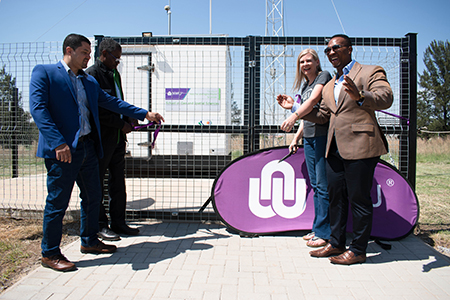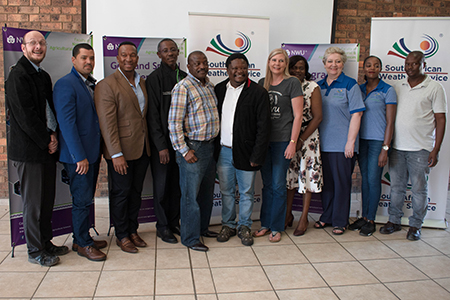v>
The North-West University (NWU), in collaboration with the South African Weather Service (SAWS), have launched a state-of-the-art observation station that will monitor both the weather and air quality.


This multi-million-rand development is situated at the campus in Vanderbijlpark, and the NWU is therefore the first higher education institution in the country to boast a permanent monitoring station on site.
The project is the brainchild of the School of Geo and Spatial Sciences in the Faculty of Natural and Agricultural Sciences, and this smart station will contribute to the local community becoming weather smart.
Addressing SA’s skills shortage
According to Emile Hoffmann, a lecturer and researcher in the Geography and Environmental Studies subject group, this observation station will contribute towards addressing the dire science, technology, engineering and mathematics (STEM) skills shortage in the country.
“Not only will the station help to grow the number of university STEM graduates, but it will also strengthen the NWU’s ability to conduct relevant and impactful research in the field of environmental studies,” says Prof Eno Ebenzo, executive dean of the faculty.
Research beacon in the Vanderbijlpark
What makes this project even more noteworthy is its positioning within the Vanderbijlpark region.
The campus is located on the banks of the Vaal River – one of South Africa’s most polluted water sources – and is right in the middle of an air pollution priority area (APPA). This is the perfect location for an observation station of this kind.
“When it comes to aspects such as air quality and pollution, areas within the region – including Emfuleni, Midvaal, Doornkop, Soweto, Diepkloof, Ennerdale, Orange Farm and Metsimaholo – are known for their environmental concerns,” says Emile.
“The station will allow researchers to collect hard data and carry out continued measurements to support intervention programmes and encourage further scientific inquiry.”
The team driving the observation station project is working alongside experts at the SAWS to ensure optimal technical precision when it comes to the real-time monitoring systems.
These systems will not only cover meteorological parameters such as rainfall, air temperature, wind speed and wind directions, but also selected priority parameters for characterising the air quality based on nearby sources of air pollution. As the project progresses, other factors such as the water level and quality of the Vaal River will also be monitored.
The beneficial long-term partnership between the NWU and the SAWS will further see the following developments taking shape:
• Opportunities for students to conduct their practical experience at the SAWS as a future employer.
• The initiation of postgraduate research projects on related topics that are done according to applied research needs, with the SAWS as co-supervisor and co-selector.
• International collaboration between South African observation networks and established global networks.
According to Prof Stuart Piketh, director of the School of Geo and Spatial Sciences, this station also advances the university’s drive towards focussed community engagement by empowering the various local communities to become more weather smart.
Data for knowledge sharing
According to Emile, a supportive smartphone app, SAAQIS*, will further contribute towards the impact of the station, since it will allow users to access environmental monitoring data by the mere push of a button.
The station is envisioned to become part of the global network of monitoring stations by conforming to the standards of the World Meteorological Organisation. According to Emile, this will enable researchers from the NWU to share data collected with not only the general public, but also the international scientific community.
Mr Mnikeli Ndabambi, executive officer for infrastructure and information systems at the SAWS, welcomes the future cooperation and collaboration with the NWU.
* The South African Air Quality Information System (SAAQIS) app can be downloaded free from the Google Play Store and is compatible with all smartphone devices. For more information, see http://www.saaqis.org.za/About.aspx

The observation station was officially opened by Warren Carter, Prof Eno Ebenzo, Prof Linda du Plessis and Absolom Mfumadi.

Some of the high-level delegates that attended the opening are from left Emile Hoffmann, Warren Carter, Absolom Mfumadi, Prof Eno Ebenso, Prof David Modise, Prof Thebe Medupe, Prof Linda du Plessis, Prof Lobina Palamuleni, Hannelee Doubell, Nomvuzo Busizi and Desmond Mabaso.
